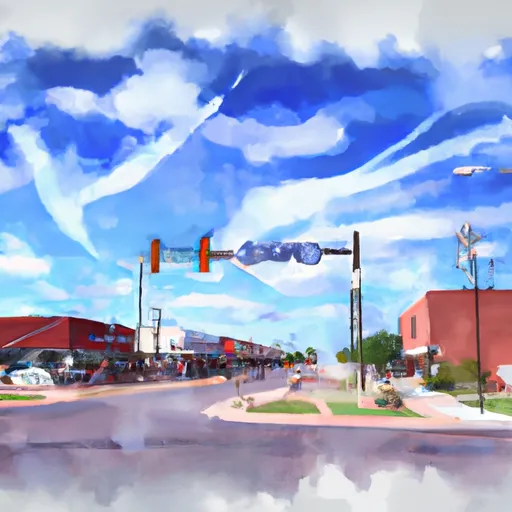-
 Snoflo Premium
Snoflo Premium
Get unlimited access to all our content
With no Ad interruptions! - Start Your Free Trial Login with existing account
Sayre
Eden Index
Climate
9.9
•
Recreation
0.3
•
Community
2.7
•
Safeguard
4.7/10

Sayre, Oklahoma, is a small town located in the western part of the state. It has a semi-arid climate with hot summers and mild winters. Summers in Sayre are typically hot, with temperatures often reaching the mid to high 90s°F (mid 30s°C). Winters are milder, with average temperatures ranging from the low 30s°F (around 0°C) to the low 50s°F (around 10°C). The town experiences around 20 inches of precipitation annually, with the majority occurring during the spring and early summer months.
Sayre is situated near the North Fork of the Red River, which provides a source of hydrology constituents for the area. The river is an important water resource for the region, supporting agriculture and wildlife habitats.
Outdoor recreation opportunities in Sayre include fishing and boating on nearby lakes such as Elk City Lake and Foss Lake. These lakes offer opportunities for anglers to catch various species of fish, including bass, crappie, and catfish. Hunting is also popular in the surrounding areas, with opportunities for deer, turkey, and quail hunting. Additionally, there are several parks and trails in and around Sayre that provide opportunities for hiking, picnicking, and enjoying the natural beauty of the area.
What is the Eden Index?
The Snoflo Eden Index serves as a comprehensive rating system for regions, evaluating their desirability through a holistic assessment of climate health, outdoor recreation opportunities, and natural disaster risk, acknowledging the profound impact of these factors on livability and well-being.
Climate Health Indicator (CHI): 9.9
Sayre receives approximately
644mm of rain per year,
with humidity levels near 61%
and air temperatures averaging around
16°C.
Sayre has a plant hardyness factor of
7, meaning
plants and agriculture in this region tend to thrive during the non-winter months.
By considering the ideal temperature range, reliable water supplies, clean air, and stable seasonal rain or snowpacks, the Climate Health Indicator (CHI) underscores the significance of a healthy climate as the foundation for quality living.
A healthy climate is paramount for ensuring a high quality of life and livability in a region, fostering both physical well-being and environmental harmony. This can be characterized by ideal temperatures, reliable access to water supplies, clean air, and consistent seasonal rain or snowpacks.
Weather Forecast
Streamflow Conditions
North Fork Red
Area Rivers
North Fork Red
Snowpack Depths
North Fork Red
Reservoir Storage Capacity
North Fork Red
Groundwater Levels
Recreational Opportunity Index (ROI): 0.3
The Recreational Opportunity Index (ROI) recognizes the value of outdoor recreational options, such as parks, hiking trails, camping sites, and fishing spots, while acknowledging that climate plays a pivotal role in ensuring the comfort and consistency of these experiences.
Access to outdoor recreational opportunities, encompassing activities such as parks, hiking, camping, and fishing, is crucial for overall well-being, and the climate plays a pivotal role in enabling and enhancing these experiences, ensuring that individuals can engage in nature-based activities comfortably and consistently.
Camping Areas
| Campground | Campsites | Reservations | Toilets | Showers | Elevation |
|---|---|---|---|---|---|
| Sayre City Park | 80 | 1,799 ft | |||
| Copper Breaks State Park | 35 | 1,462 ft | |||
| Beaver Point - Fort Supply Lake | None | 2,015 ft | |||
| Supply Park - Fort Supply Lake | None | 1,991 ft |
Nearby Ski Areas
Catastrophe Safeguard Index (CSI):
The Catastrophe Safeguard Index (CSI) recognizes that natural disaster risk, encompassing floods, fires, hurricanes, and tornadoes, can drastically affect safety and the overall appeal of an area.
The level of natural disaster risk in a region significantly affects safety and the overall livability, with climate change amplifying these risks by potentially increasing the frequency and intensity of events like floods, fires, hurricanes, and tornadoes, thereby posing substantial challenges to community resilience and well-being.
Community Resilience Indicator (CRI): 2.7
The Community Resilience Indicator (CRI) recognizes that education, healthcare, and socioeconomics are crucial to the well-being of a region. The CRI acknowledges the profound impact of these elements on residents' overall quality of life. By evaluating educational resources, healthcare accessibility, and economic inclusivity, the index captures the essential aspects that contribute to a thriving community, fostering resident satisfaction, equity, and social cohesion.

